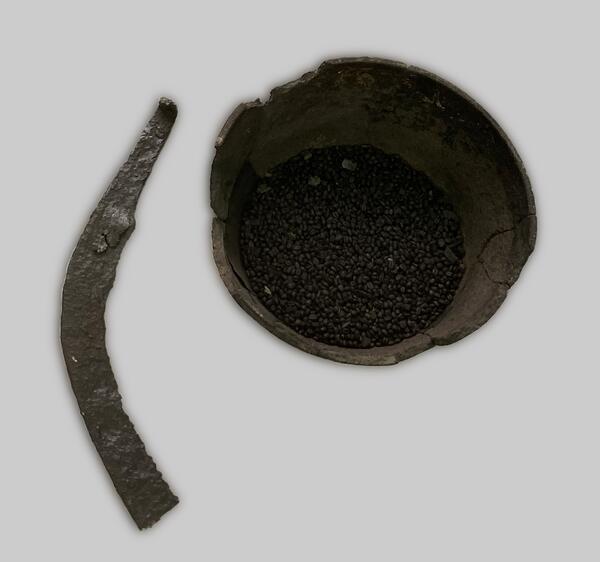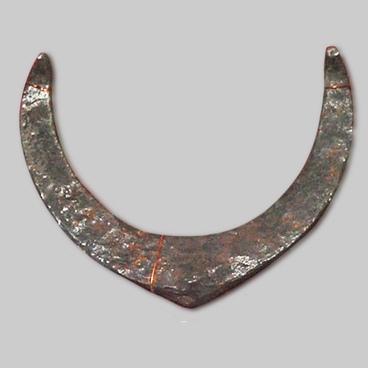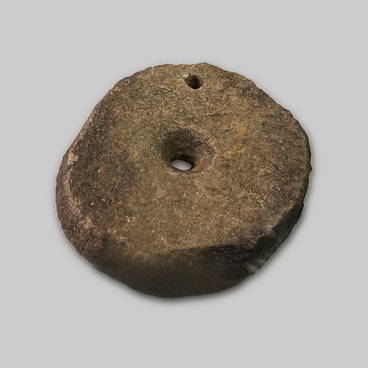Scythe is an agricultural hand tool for grass cutting: to make hay, cattle fodder or to trim the lawn. The hand scythe consists of a chisel – a metal blade with a stick attached to its base – a scythe shaft, a snath. In the middle of the shaft of Lithuanian scythe there is a bow – a handle to comfortably hold of the tool. The scythe blade is attached to the shaft by a wooden wedge and a metal ring, less frequently, by two rings.
Indoor maintenance of cattle typical for the Russian population of Siberia required stocking up enough fodder, including hay. The hunchback scythe was an important agricultural tool. Living in a border town, Kuznetsk residents did not always have an opportunity to select convenient meadow plots and preferred the nearest ones. The hunchback scythe was convenient for working at small meadow plots with high grass which are many in the city neighbourhood even now.
The hunchback scythe is a cutting agricultural tool used for grass cutting. It is a northern type of scythes. In the classification of the Russian historian and archaeologist Boris Kolchin, typical for northern scythes are a lengthened narrow blade and an oblong shaft. The scythe was attached to a wooden handle with its stick part, using a metal ring.
The scythers worked with hunchback scythe in a bent-down position moving the tool on both sides of the body – and that made the tool different from the scythe with a long handle – a Lithuanian scythe. The latter was more difficult to manufacture and required more metal. It was more hazardous in work and required special skills, but at the same time its productivity was higher than that of the hunchback scythe.
The museum collection only contains fragments of the tanged hunchback scythe, its surface is distorted. The working part is bent arc-wise, the back is flattened and smoothly changes into the shaft. The usual length of the hunchback scythe in XVII century was 40 cm from the shaft to the blade end. Manufacturing technique was simple, comprising hot metal forging methods. Carbon steel was used as feedstock. The ready tool was thermohardened in cold water. As the result the steel became very hard but at the same time, fragile, that being the reason behind the blade breaking while working with it.
Indoor maintenance of cattle typical for the Russian population of Siberia required stocking up enough fodder, including hay. The hunchback scythe was an important agricultural tool. Living in a border town, Kuznetsk residents did not always have an opportunity to select convenient meadow plots and preferred the nearest ones. The hunchback scythe was convenient for working at small meadow plots with high grass which are many in the city neighbourhood even now.
The hunchback scythe is a cutting agricultural tool used for grass cutting. It is a northern type of scythes. In the classification of the Russian historian and archaeologist Boris Kolchin, typical for northern scythes are a lengthened narrow blade and an oblong shaft. The scythe was attached to a wooden handle with its stick part, using a metal ring.
The scythers worked with hunchback scythe in a bent-down position moving the tool on both sides of the body – and that made the tool different from the scythe with a long handle – a Lithuanian scythe. The latter was more difficult to manufacture and required more metal. It was more hazardous in work and required special skills, but at the same time its productivity was higher than that of the hunchback scythe.
The museum collection only contains fragments of the tanged hunchback scythe, its surface is distorted. The working part is bent arc-wise, the back is flattened and smoothly changes into the shaft. The usual length of the hunchback scythe in XVII century was 40 cm from the shaft to the blade end. Manufacturing technique was simple, comprising hot metal forging methods. Carbon steel was used as feedstock. The ready tool was thermohardened in cold water. As the result the steel became very hard but at the same time, fragile, that being the reason behind the blade breaking while working with it.



